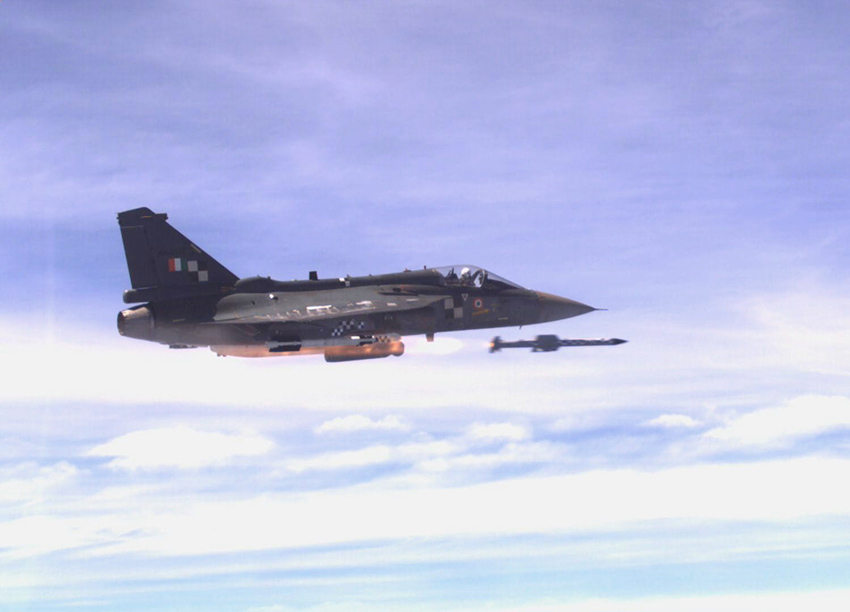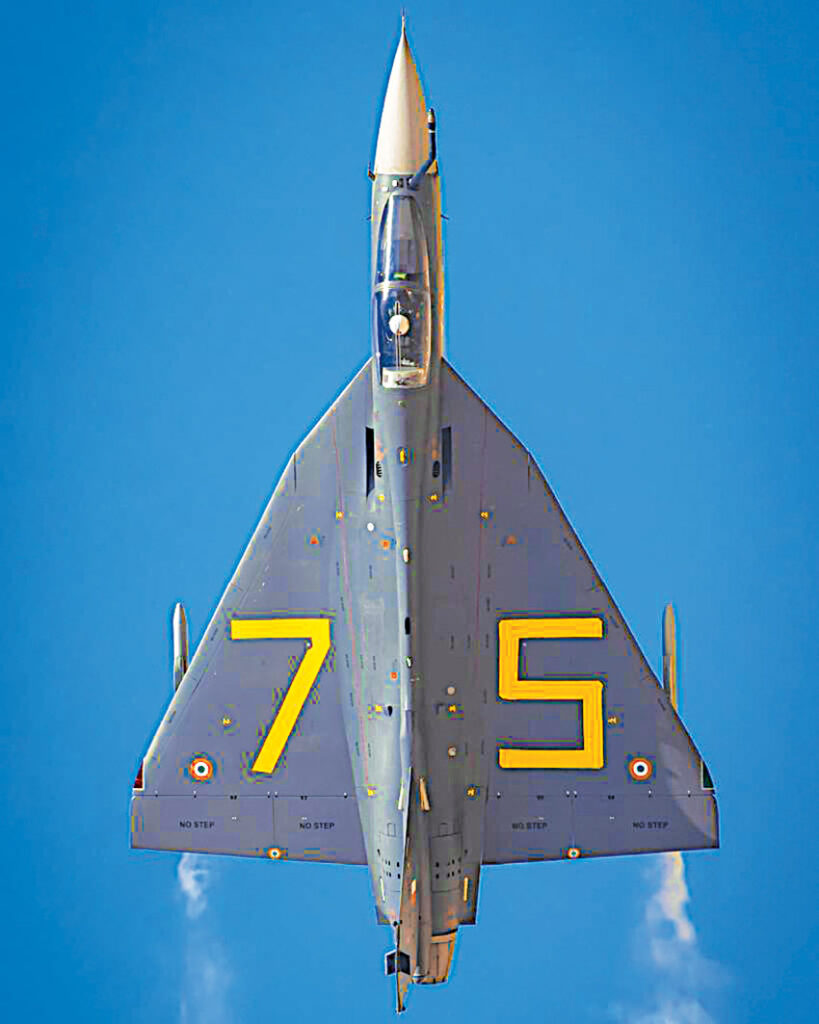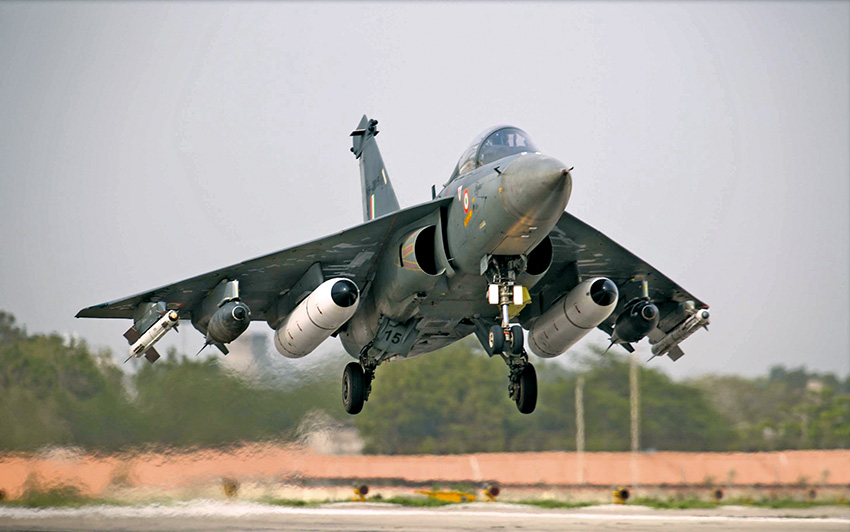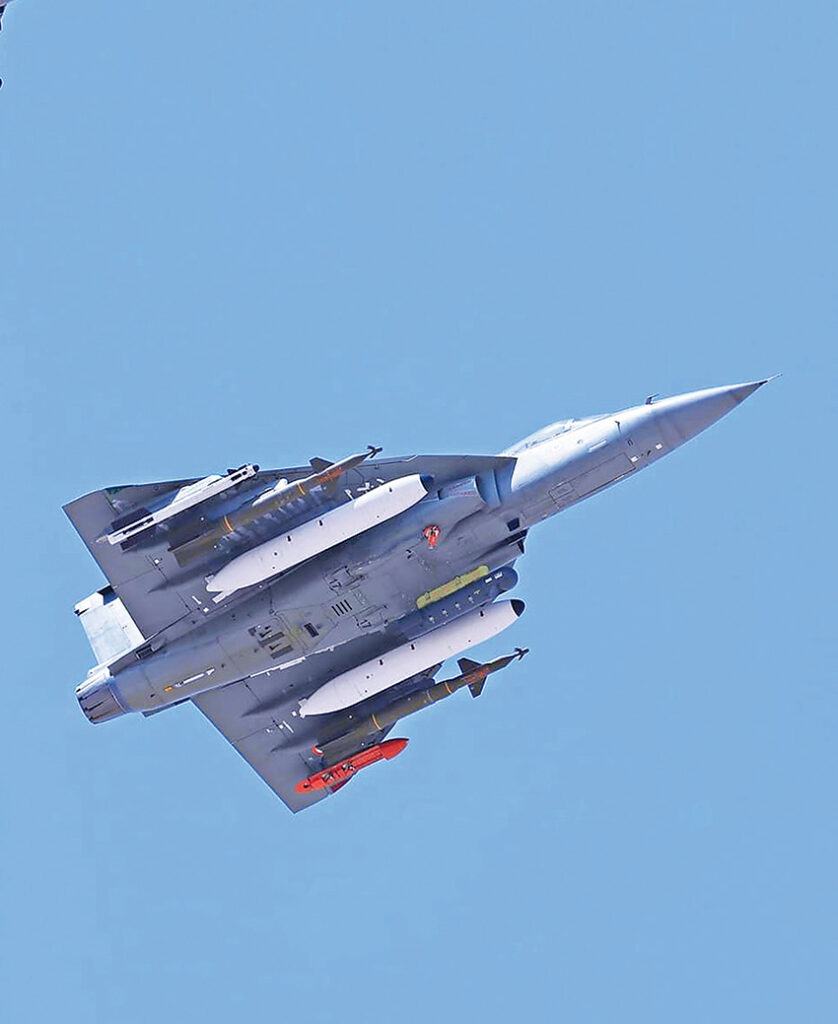Radiance of Tejas: Touching the Sky with Glory
By Gp Capt (Dr) DK Pandey (Retd)
The indigenous Light Combat Aircraft (LCA) reached its seven-year service milestone in the Indian Air Force (IAF) on 01 July 2023. The aircraft, christened Tejas, or Radiance, in 2003, is a versatile platform considered one of the best in its category. IAF operates the platform in Air Defence, Maritime Reconnaissance, and Strike roles. The fundamentally dynamic Tejas provides seamless control and excellent manoeuvrability. The system’s capacity is augmented by its Multi-Mode Airborne radar, Helmet Mounted Display, Self-protection suite, and Laser Designation Pod.

IAF has demonstrated India’s self-developed aerospace capabilities by presenting the aircraft at many global events, such as LIMA-2019 in Malaysia, Dubai Air Show-2021 and 2023, Sri Lanka Air Force anniversary celebrations in 2021, Singapore Air Show-2022, and Aero India Shows spanning from 2017 to 2023. Although the Tejas has previously engaged in joint training exercises with foreign air forces within its own country, the Ex-Desert Flag in the United Arab Emirates in March 2023 was its first participation in an exercise in foreign airspace. Multiple nations, such as Egypt, Argentina, Indonesia, Malaysia, and the Philippines, have expressed interest in acquiring the Tejas aircraft.
IAF’s faith in the Tejas is evident from its procurement of 83 LCA Mk-1A aircraft. During the Air Force Day press conference, Air Chief Marshal V R Chaudhari stated that the agreement for the procurement of 97 more Tejas Mk 1A aircraft is being finalised shortly. On 30 Nov 2023, the Defence Acquisition Council (DAC) approved this requirement.

Tejas Mk-1A will be equipped with advanced avionics, an Active Electronically Steered Radar, an upgraded Electronic Warfare suite, and the capacity to launch Beyond Visual Range (BVR) Astra missiles. There will be many indigenous weaponry among them. The LCA MK-1A will experience a significant rise in the total proportion of components and materials that are produced domestically inside the country.
By weight, more than 45% of its airframe and more than 90% of its surface are made of composite structures. As a result of this extensive use of composites, the aircraft’s weight and number of components have been reduced by 21% and 40%, respectively, compared to what would have occurred if constructed entirely of metal.
HAL is parallelly developing the Tejas Mk2, a larger and more advanced version of the Tejas, to meet the IAF’s future requirements for a medium-weight fighter aircraft.
The Indian combat aviation ecosystem has a formidable job in order to accomplish the delivery of 180 Tejas aircraft. Assuring production and delivery schedules and maintaining the required level of aircraft quality should be the major priorities.
The Aircraft Architecture
LCA Tejas is a multi-role, single-seat, single-engine, lightweight, high-agility multirole, all-weather supersonic fighter aircraft of the 4.5 generation. The aircraft has been engineered to effortlessly execute ground attack, close combat, and offensive air support missions with the capability to launch a wide array of weapons at a greater range. Additionally, it is engineered to perform ground maritime operations.

The Tejas fighter aircraft is manufactured by Hindustan Aeronautics Limited (HAL). Tejas is primarily known as the LCA, designed by the Aeronautical Development Agency (ADA) in collaboration with the Aircraft Research and Design Centre of HAL to meet the requirements of the Indian Air Force and Navy. In fact, ADA, under India’s Ministry of Defence, was set up in Bangalore in 1984 with the purpose of directing the advancement of the country’s LCA initiative. Presently, it is engaged in the creation and advancement of several iterations of LCA, HAL AMCA, and UCAV.
The aircraft carrier INS Vikramaditya of the Indian Navy was the site of a successful flight test of the Tejas naval prototype in January 2020. And IAF is flying the first Tejas Mk1 with final operational clearance (FOC) configuration.
The LCA Mk1A represents the pinnacle of LCA Tejas development. It is outfitted with a GE F404 -IN20 engine, which has thrust (After / Burner) 85KN, AESA (Active Electronically Scanned Array) Radar with low likelihood of interception, an EW suite comprising self-protection interference and radar warning, a Combined Interrogator and Transponder (CIT), a Digital Map Generator (DMG), and Smart Multi-function Displays (SMFD). that has a low likelihood of interception. Tejas can fire a range of armaments with the necessary precision and accuracy. It has nine hard points and can launch long-range BVR & WVR missiles, bombs, etc.
The Exclusivity
The aircraft is the most compact and lightweight among others in its class. The aircraft has an outstanding track record of flight safety and consistently impressive accomplishments.
The compound tail-less delta is a kind of aircraft design that enhances the aircraft’s ability to carry a broader array of weaponry, such as bombs and missiles. The In-Flight Refuelling probe extends the range of the aircraft during missions, day or night.
The Mission Computer is an indigenously developed system that utilises open architecture, offering interoperability, scalability, and portability. The flight control system is equipped with a fully redundant quadruplex digital fly-by-wire system, which greatly simplifies pilot handling. It has nine hard points and can launch long-range BVR & WVR missiles, bombs, etc.
Progression of Tejas
The evolution of the HAL’s Tejas LCA has been a prolonged and challenging process that has lasted for more than 30 years. Since its inception in the 1980s as a substitute for the ageing MiG-21 fighters, the Tejas has undergone several design modifications, technical breakthroughs, and testing stages to evolve into a powerful light combat aircraft.
The inaugural flight of the LCA Technology Demonstrator-1 (TD-1) took place on January 4, 2001. The LCA development has established a cutting-edge network of aeronautical laboratories, enabling India to possess the exceptional capacity to conceive and construct fighter aircraft. Reestablishing this capacity, following an interruption of almost 40 years, is a remarkable accomplishment.

Despite experiencing significant delays, the LCA project has achieved great success as it stands out as one of the finest “Light Weight Fighter Aircraft” in the current age. The LCA incorporates indigenous development of advanced technologies such as digital Fly-By-Wire, Mission Computer-Controlled Avionics, and Composite Materials. India has successfully bridged a significant technological disparity by advancing from a first-generation Marut (HF-24) fighter to a fourth-generation combat jet. The successful creation of a sophisticated fighter aircraft has instilled confidence in our aerospace community to begin working on the next iteration of airborne platforms.
IAF inducted Tejas in July 2016. The first squadron of the IAF to introduce the Tejas aircraft was the No 45 squadron, known as the ‘Flying Daggers’. Every aircraft operated by the Flying Daggers has been produced in India, either through licenced manufacturing or through indigenous design and development. In May 2020, No 18 Squadron became the second unit of the IAF to utilise the Tejas aircraft.
The Tejas LCA programme has achieved notable advancements, as the Mk1 model was formally awarded Final Operational Clearance (FOC) on February 20, 2019. Additionally, the production of the aircraft at HAL has been accelerating.
HAL is parallelly developing the Tejas Mk2, a larger and more advanced version of the Tejas, to meet the IAF’s future requirements for a medium-weight fighter aircraft.
Conclusion
The Tejas LCA serves as a representation of India’s expanding aerospace capabilities and its dedication to achieving self-sufficiency in military technologies. The programme has not only furnished the IAF with a contemporary fighter aircraft, but it has also catalysed the growth of a robust domestic aerospace ecosystem.
The development of the Tejas LCA is evidence of India’s expanding expertise in aeronautical engineering and production. The Tejas aircraft has not only upgraded the capabilities of the IAF but has also positioned itself as a reliable choice for sale, demonstrating India’s capacity in the international defence market. The ongoing development of the Tejas LCA positions it to assume a progressively significant role in protecting India’s airspace and asserting its strategic influence in the area.





